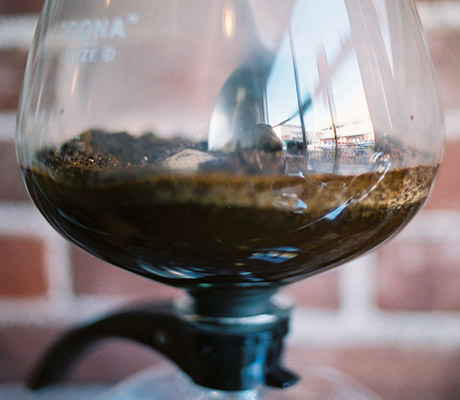I'll tell you six special things about coffee.
Article 1
Study on imitating coffee milk beverage
The invention relates to a Cassia seed imitation coffee drink and a preparation method thereof. the main raw materials are as follows: 60-80 parts of cassia seed, 5-10 parts of sweet almonds, 5-10 parts of walnut kernels, 3-5 parts of black sesame, 3-5 parts of Coix, 1-3 parts of white lentils, 1-3 parts of black lentils, 1-3 parts of Ganoderma lucidum and 0.3-0.8 parts of edible bamboo charcoal powder. It is prepared by the processes of roasting and crushing of germinated cassia seed and black sesame respectively, extraction, concentration and drying of Wuling bacteria and Ganoderma lucidum, crushing, mixing and sub-packaging of other raw materials. The imitation coffee functional drink of the invention not only has unique color, flavor, aroma and taste of coffee drink, but also has health functions such as clearing liver and eyesight, reducing blood pressure and lipid, moistening intestines and defecation, etc., and is suitable for drinking by all kinds of people. in particular, it is suitable for patients with hypertension, coronary heart disease, hyperlipidemia, calcium deficiency and constipation who are not suitable for drinking coffee, and is rich in resources and easy to obtain raw materials, and has great market application and promotion value.
Article 2
Study on imitating coffee milk beverage
The best combination and processing conditions of coffee-flavored milk beverage were processed with cassia seed, skim milk powder, soybean sprout, wheat and so on. The results showed that when Cassia seed and soybean sprout were baked, wheat was fried and crushed, added to water in the proportion of 2g cassia seed, 1.5g soybean sprout and 0.6g wheat, extracted at 95 ℃ for 1 h, filtered, and then dissolved in skim milk powder 3G, the beverage with pure and thick color, moderate bitterness, easy digestion and absorption, coffee taste and flavor but without caffeine could be obtained.
Article 3
Preparation method of instant Lycium barbarum coffee powder
A method for preparing instant Chinese wolfberry coffee powder comprises the following steps: 1) Chinese wolfberry was pulped with water, 10~15min was extracted at 80 ℃, filtered and filtered into Chinese wolfberry juice; 2) coffee beans were roasted and ground to 100 × 200 mesh fine powder; 3) coffee powder was extracted with water at 175 to 180 ℃, and the extract was concentrated and dried to obtain instant coffee powder. 4) the instant coffee powder, Chinese wolfberry juice, sucrose and stabilizer were mixed according to the weight ratio of 20: 40, 1: 3, 4: 8, 0.1: 0.4, homogenized, concentrated, dried, and the instant Chinese wolfberry coffee powder was obtained. The Chinese wolfberry coffee powder prepared from Chinese wolfberry and coffee after treatment has good taste, rich nutrition, eye-catching and refreshing, is a functional beverage integrating nutrition and health care, and accords with the consumption concept and demand of contemporary consumers.
Article 4
Analysis of aroma components of coffee beans from different producing areas
The volatile components and their contents of 16 kinds of roasted coffee beans were analyzed, and the differences of aroma components of roasted coffee beans were studied. The volatile aroma components of each sample were extracted by simultaneous distillation and extraction. The volatile components in coffee were analyzed by gas chromatography-mass spectrometry (GC-MS). The data were analyzed qualitatively and quantitatively, and the data were analyzed by cluster analysis and principal component analysis with SPSS19.0 software. From the data analysis, it can be seen that the aroma components of coffee from different producing areas are basically similar under moderate roasting conditions. the contents of high-content ingredients such as 2-methylpyrazine, furfuryl alcohol, 5-methylfuranal, 2-ethyl-5-methylpyrazine, 2-ethyl-3, 5-dimethylpyrazine and so on are different. Through cluster analysis, it can be seen that the cluster analysis of volatile aroma components of coffee can reflect the similarity of coffee aroma in different producing areas. According to the principal component analysis of the volatile components of coffee, the first five principal components can be used to explain the aroma of coffee.
Article 5
Effects of two extraction methods and two varieties of coffee beans on the aroma of coffee extract
Arabica bean and Robbosa bean were extracted by continuous extraction and high pressure extraction, and 12 °B é coffee extract was obtained. The aroma was extracted by solid phase microextraction (SPME) and analyzed by gas chromatography-mass spectrometry (GC-MS). The effects of different extraction methods and coffee beans on the aroma components of the extract were studied. The aroma components of coffee liquid obtained by continuous extraction and high pressure extraction were 30 and 26 respectively, while those of Arabica bean were 28. The aroma components and content of coffee extract obtained by different extraction methods of the same coffee bean were different, and the aroma components obtained by continuous extraction were more abundant. The aroma components and contents of the extract obtained by the same extraction method of different coffee beans are different. Robusta bean coffee liquid tends to roast, nut, chocolate, scorch, pine and soil flavor, while Arabica bean coffee liquid tends to sour, sweet, creamy, nut, fruit, roast and woody, and Arabica bean extract is more abundant than Robsta bean extract.
Article 6
Study on the effect of Baking conditions on the component content of Coffee Bean
By means of Kjeldahl method, visible spectrophotometry, burette method, muffle method, Soxhlet extraction method and SPSS17.0 data statistical analysis software, the effects of baking conditions on protein, total sugar, starch, fat and ash of raw and roasted beans of Vietnamese Robasda coffee were studied. The results showed that Vietnam Robasta coffee was a coffee bean variety with high protein content and low fat content. With the increase of baking degree and baking temperature, the content of protein and starch increased at first and then decreased slightly, while the content of total sugar decreased significantly, and the content of fat and ash increased significantly. The range of composition: protein content 14.50%-17.20%, starch content 16.30%-25.30%, total sugar content 0.687%-4.340%, fat content 7.64%-12.50%, ash content 3.47% ~
The content of the article comes from the Internet.
Important Notice :
前街咖啡 FrontStreet Coffee has moved to new addredd:
FrontStreet Coffee Address: 315,Donghua East Road,GuangZhou
Tel:020 38364473
- Prev

Introduction to the knowledge and stage of Coffee roasting
A series of chemical changes occur during the baking process. After about 5-25 minutes of baking (depending on the temperature selected), the green coffee beans lose some humidity and turn yellow. In this process, the coffee beans will swell, changing from a strong, high-density raw bean to a low-density fluffy state. After this process, the size of the coffee beans will about double, starting
- Next

How to brew coffee beans How to brew coffee beans How to brew coffee beans
Extraction time Practical parameters: 40~50 seconds Light medium baking taste light, can also inhibit the charred bitterness of deep baking beans 50~60 seconds moderate intensity, suitable for light baking, medium baking and deep baking for more than 60 seconds concentration, viscosity, aroma and miscellaneous bitterness, suitable for heavy taste old smoke match The brewing time is about 40~60 seconds, depending on the taste intensity and baking degree. If the baking degree is deeper or lighter,
Related
- Beginners will see the "Coffee pull flower" guide!
- What is the difference between ice blog purified milk and ordinary milk coffee?
- Why is the Philippines the largest producer of crops in Liberia?
- For coffee extraction, should the fine powder be retained?
- How does extracted espresso fill pressed powder? How much strength does it take to press the powder?
- How to make jasmine cold extract coffee? Is the jasmine + latte good?
- Will this little toy really make the coffee taste better? How does Lily Drip affect coffee extraction?
- Will the action of slapping the filter cup also affect coffee extraction?
- What's the difference between powder-to-water ratio and powder-to-liquid ratio?
- What is the Ethiopian local species? What does it have to do with Heirloom native species?

